RBSE Solutions for Class 12 Maths Chapter 4 Determinants Miscellaneous Exercise
Rajasthan Board RBSE Solutions for Class 12 Maths Chapter 4 Determinants Miscellaneous Exercise Textbook Exercise Questions and Answers.
Rajasthan Board RBSE Solutions for Class 12 Maths in Hindi Medium & English Medium are part of RBSE Solutions for Class 12. Students can also read RBSE Class 12 Maths Important Questions for exam preparation. Students can also go through RBSE Class 12 Maths Notes to understand and remember the concepts easily.
RBSE Class 12 Maths Solutions Chapter 4 Determinants Miscellaneous Exercise
Question 1.
Prove that the determinant x \(\left|\begin{array}{ccc} x & \sin \theta & \cos \theta \\ -\sin \theta & -x & 1 \\ \cos \theta & 1 & x \end{array}\right|\) is independent of θ.
Answer:
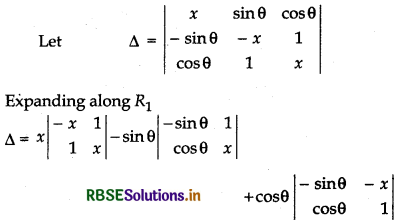
= x(- x2 - 1) - sin θ (- x sin θ - cos θ) + cos θ (- sin θ + x cos θ)
= x(- x2 - 1) + x sin2 θ + sin θ cos θ - cos θ sin θ + x cos2 θ
= - x3 - x + x(sin2 θ + cos2 θ)
= - x3 - x + x × 1 = - x3
Clearly, ∆ is independent of θ.
Hence Proved.

Question 2.
Without expanding the determinant, prove that
\(\left|\begin{array}{ccc} a & a^{2} & b c \\ b & b^{2} & c a \\ c & c^{2} & a b \end{array}\right|\)=\(\left|\begin{array}{ccc} 1 & a^{2} & a^{3} \\ 1 & b^{2} & b^{3} \\ 1 & c^{2} & c^{3} \end{array}\right|\)
Answer:
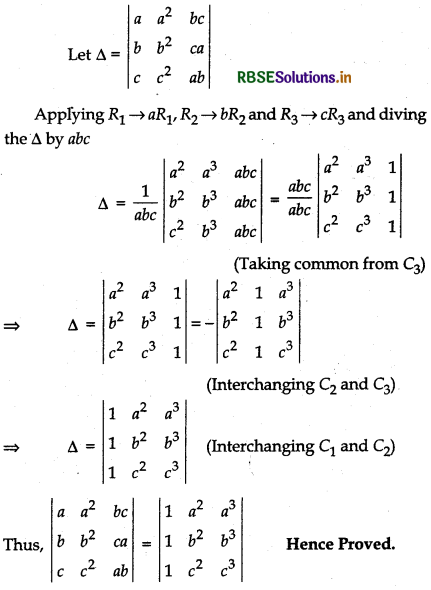
Question 3.
Evaluate
\(\left|\begin{array}{ccc} \cos \alpha \cos \beta & \cos \alpha \sin \beta & -\sin \alpha \\ -\sin \beta & \cos \beta & 0 \\ \sin \alpha \cos \beta & \sin \alpha \sin \beta & \cos \alpha \end{array}\right|\)
Answer:
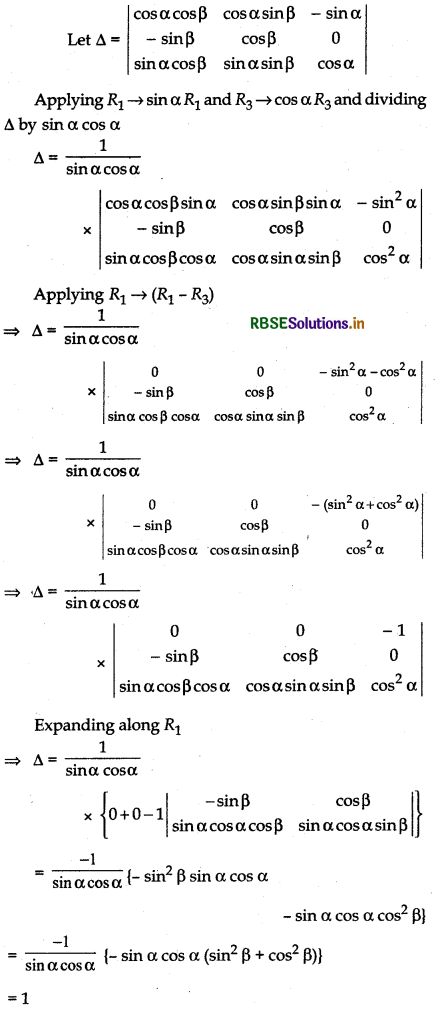

Question 4.
If a, b and c are real numbers and
Δ = \(\left|\begin{array}{lll} b+c & c+a & a+b \\ c+a & a+b & b+c \\ a+b & b+c & c+a \end{array}\right|\) = 0
then show that either a + b + c = 0 and a = b = c.
Answer:
Given determinant is:
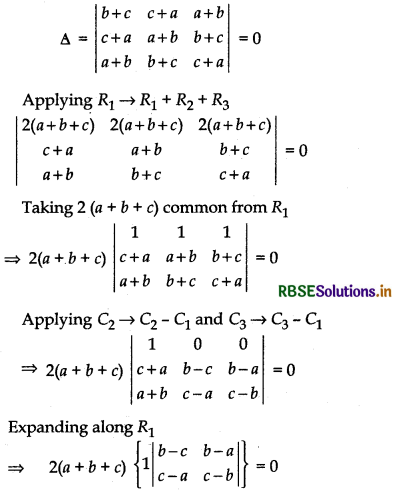
⇒ 2(a + b + c) {(b - c) × (c - b) - (c - a) (b - a)} = 0
⇒ 2(a + b + c) {- (b - c)2 - (cb - ca - ab + a2)} = 0
⇒ 2(a + b + c) {- b2 - c2 + 2bc - bc + ca + ab - a2} = 0
⇒ 2(a + b + c) × {- a2 - b2 - c2 + bc + ca + ab} = 0
⇒ - 2(a + b + c) × {a2 + b2 + c2 - ab - bc - ca] = 0
⇒ -(a + b + c) {2a2 + 2b2 + 2c2 - 2ab - 2bc - 2ca] = 0
⇒ - (a + b + c) {(a2 + b2 - 2ab + b2 + c2 - 2ab + c2 + a2 - 2ac} = 0
⇒ - (a + b + c) × {(a - b)2 + {b - c)2 + (c - a)2} = 0
⇒ a + b + c = 0
or (a - b)2 + (b - c)22 + (c - a)2 = 0
⇒ a - b = 0, b - c = 0, c - a = 0
⇒ a = b, b = c, c = a
⇒ a = b = c
Hence a + b + c = 0
or a = b = c
Hence Proved.

Question 5.
If a ≠ 0 then, solve
\(\left|\begin{array}{ccc} x+a & x & x \\ x & x+a & x \\ x & x & x+a \end{array}\right|\) = 0
Answer:
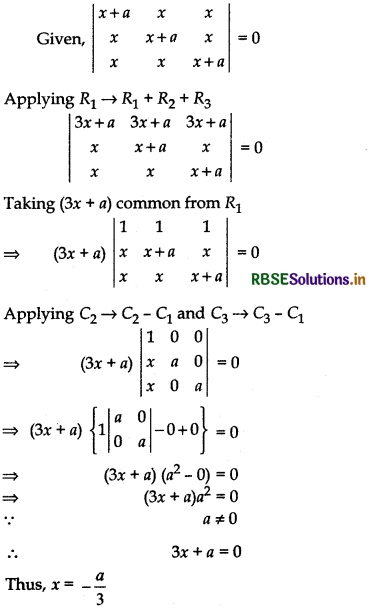
Question 6.
Prove that
\(\left|\begin{array}{ccc} a^{2} & b c & a c+c^{2} \\ a^{2}+a b & b^{2} & a c \\ a b & b^{2}+b c & c^{2} \end{array}\right|\) = 4a2b2c2
Answer:
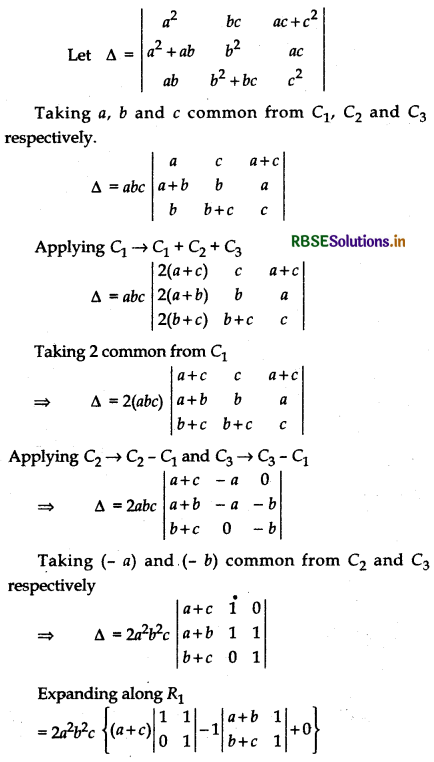
= 2a2b2c {(a + c) (1 - 0) - 1(a + b -b - c)}
= 2a2b2c{a + c - a - b + b + c}
= 2a2b2c(2c)
= 4a2b2c2
Hence Proved.

Question 7.
If A-1 = \(\left[\begin{array}{rrr} 3 & -1 & 1 \\ -15 & 6 & -5 \\ 5 & -2 & 2 \end{array}\right]\) and B = \(\left[\begin{array}{rrr} 1 & 2 & -2 \\ -1 & 3 & 0 \\ 0 & -2 & 1 \end{array}\right]\) then find the value of (AB)-1.
Answer:
We have,
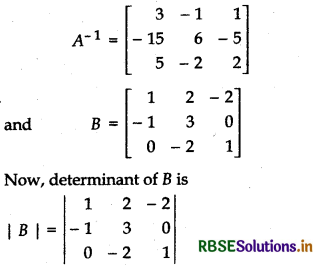
= 1(3 - 0) - 2(-1 - 0) - 2(2 - 0)
= 3 + 2 - 4 = 1
∴ |B| = 1 ≠ 0
Since, B is non-singular so B-1 exists.
If Bij is cofactor of bij in B, then
B11 = + [3 × 1 - (- 2) × 0] = 3
B12 = (- 1) (- 1) - 0 = 1
B13 = + [(- 1) × (- 2) - 0 × 3] = 2
B21 = (- 1) (2 - 4) = (- 1) (- 2) = 2
B22 = + [1 × 1 - 0 (- 2) = 1
B23 = (- 1) [1 × (- 2) - 0 × 2] = 2
B31 = + [2 × 0 - 3 × (- 2)] = 6
B32 = (- 1) [0 - (- 1) (- 2)] = 2
B33 = + [1 × 3 - (-1) × 2] = 3 + 2 = 5
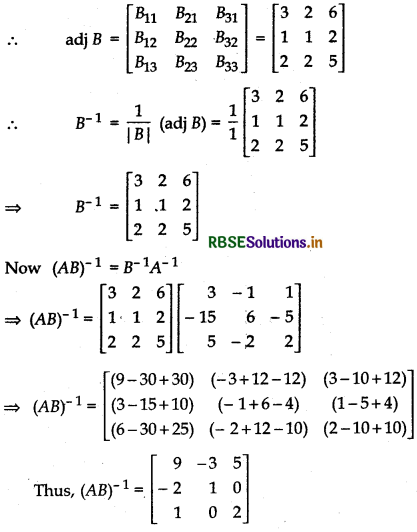

Question 8.
Let A = \(\left[\begin{array}{rrr} 1 & -2 & 1 \\ -2 & 3 & 1 \\ 1 & 1 & 5 \end{array}\right]\), then verify that
(i) (adj A)-1 = (adj) A-1
Answer:
Given, A = \(\left[\begin{array}{rrr} 1 & -2 & 1 \\ -2 & 3 & 1 \\ 1 & 1 & 5 \end{array}\right]\)
Determinant of matrix A,
|A| = \(\left|\begin{array}{rrr} 1 & -2 & 1 \\ -2 & 3 & 1 \\ 1 & 1 & 5 \end{array}\right|\)
= (15 - 1) + 2(- 10 - 1) + (- 2 - 3)
= 14 + 2(- 11) + (- 5)
= 14 - 22 - 5 = - 13
∴ | A | = - 13 ≠ 0
Since, matrix A is non-singular so A-1 exists.
If Aij is cofactor of aij in A, then
A11 = + [3 × 5 - 1 × 1] = 15 - 1 = 14
A12 = (- 1) [- 10 - 1] = 11
A13 = + [- 2 × 1 - 1 × 3] = - 2 - 3 = - 5
A21 = (- 1) [- 10 - 1] = (- 1) × (- 11) = 11
A22 = + [1 × 5 - 1 × 1] = 5 - 1 = 4
A23 = (- 1) [1 + 2] = (- 1) × 3 = - 3
A31 = + [- 2 × 1 - 3 × 1] = - 2 - 3 = - 5
A32 = (- 1) [1 + 2] = (- 1) (3) = - 3
A33 = + [1 × 3 - (- 2) × (- 2)] = 3 - 4 = - 1
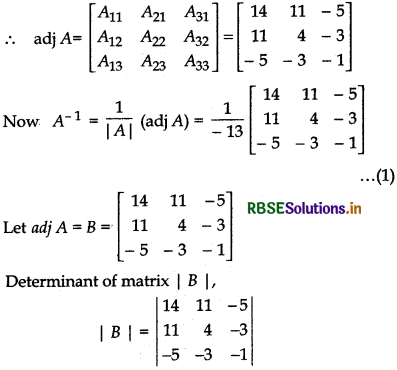
= 14(- 4 - 9) - 11(- 11 - 15) - 5(- 33 + 20)
= 14(- 13) - 11(- 26) - 5 (-13)
= - 182 + 286 + 65 = 169
∴ |B| = 169 ≠ 0
Since, matrix B is non-singular so B-1 exists.
If Bij is cofactor of bij in B, then
B11 = + [4 × (-1) - (- 3) × (- 3)] = - 4 - 9 = -13
B12 = (- 1) (- 11 - 15)] = (- 1) (- 26) = 26
B13 = + [11 × (- 3) - (- 5) × 4] = - 33 + 20 = - 13
B21 = (- 1) [- 11 - 15)] = (- 1) (- 26) = 26
B22 = + [14 × (- 1) - (- 5) × (- 5)] = -14 - 25 = - 39
B23 = (- 1) (- 42 + 55) = (- 1) (13) = - 13
B31 = + [11 × (- 3) - 4 × (- 5)] = - 33 + 20 = - 13
B32 = (- 1) [- 42 + 55] = (- 1) (13) = - 13
B33 = + [14 × 4 - 11 × 11] = 56 - 121 = - 65
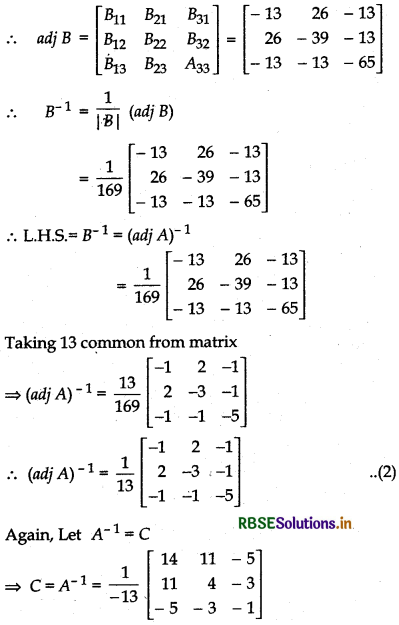
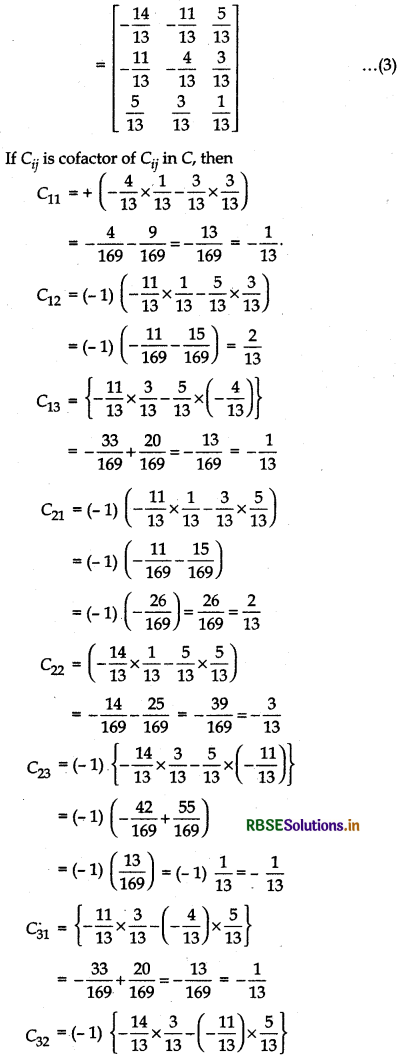
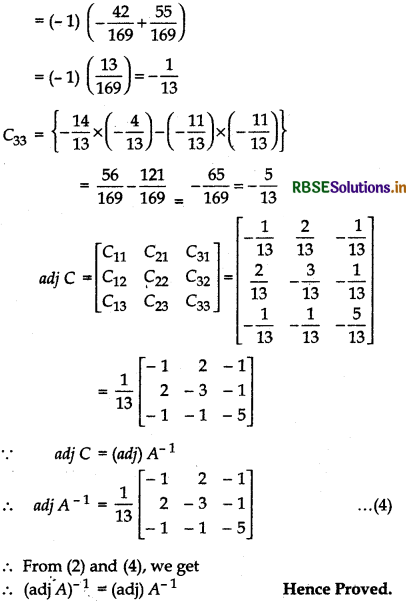

(ii) (A-1)-1 = A
Answer:
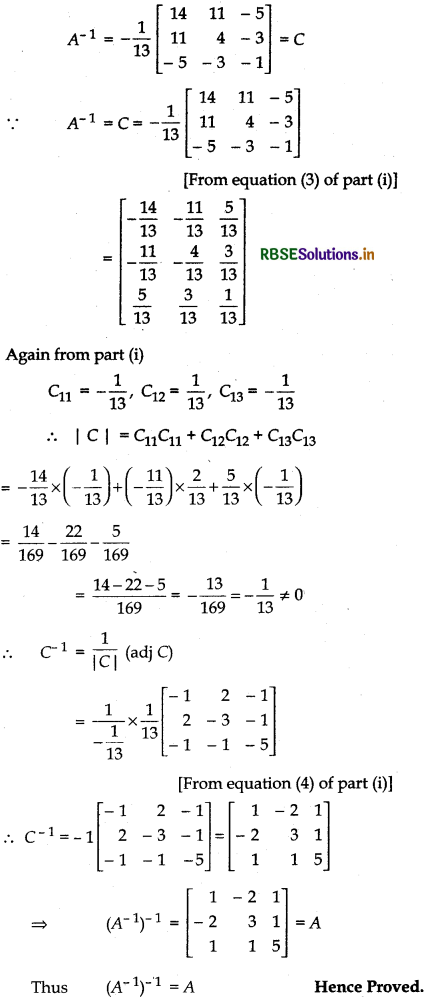
Question 9.
Evaluate: \(\left|\begin{array}{ccc} x & y & x+y \\ y & x+y & x \\ x+y & x & y \end{array}\right|\)
Answer:
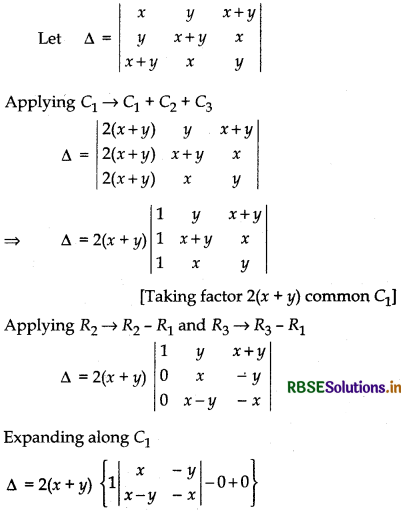
= 2(x + y) {x × (- x) - (x - y) × (- y)}
= 2(x + y) {- x2 + xy - y2}
= - 2(x + y) (x2 - xy + y2)
= - 2(x3 + y3)

Question 10.
\(\left|\begin{array}{ccc} 1 & x & y \\ 1 & x+y & y \\ 1 & x & x+y \end{array}\right|\)
Answer:
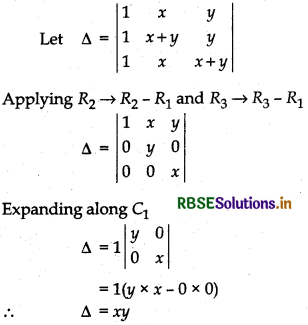
Using properties of determinants in Question 11 to 15. Prove that
Question 11.
\(\left|\begin{array}{ccc} \alpha & \alpha^{2} & \beta+\gamma \\ \beta & \beta^{2} & \gamma+\alpha \\ \gamma & \gamma^{2} & \alpha+\beta \end{array}\right|\) = (β - γ) (γ - α) (α - β) (α + β + γ)
Answer:
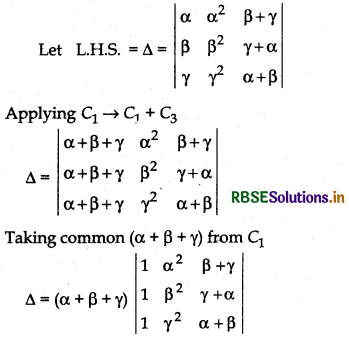
Applying R2 → R2 - R1 and R3 → R3 - R1

Taking common (β - α) and (γ - α) from R2 and R3 respectively
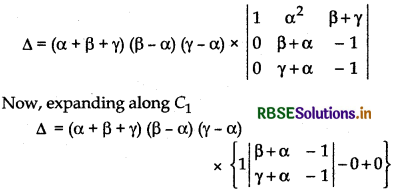
⇒ ∆ = (α + β + γ) (β - α) (γ - α) × {(β - α) (- 1) - (γ + α) (- 1)}
⇒ ∆ = (α + β + γ) (β - α) (γ - α) × (- β - α + γ + α)
⇒ ∆ = (α + β + γ) (β - α) (γ - α) (- β + γ)
⇒ ∆ = (α + β + γ) (α - β) (γ - α) (γ - β) [∵ (β - α) = - (α - β), (γ - β) = - (β - γ)]
⇒ ∆ = (α + β + γ) (α - β) (β - γ) (γ - α)
= R.H.S
Hence Proved.

Question 12.
\(\left|\begin{array}{ccc} x & x^{2} & 1+p x^{3} \\ y & y^{2} & 1+p y^{3} \\ z & z^{2} & 1+p z^{3} \end{array}\right|\) = (1 + pxyz) (x - y) (y - z) (z - x), where p is any scalar.
Answer:
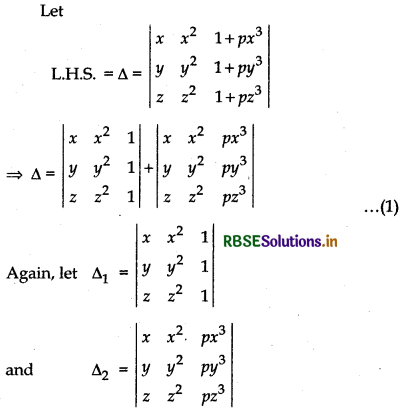
Now, in ∆1, applying R2 → R2 - R1 and R3 → R3 - R1
∆1 = \(\left|\begin{array}{ccc} x & x^{2} & 1 \\ y-x & y^{2}-x^{2} & 0 \\ z-x & z^{2}-x^{2} & 0 \end{array}\right|\)
Taking factor (y - z) and (z - x) common from R2 and R3 respectively
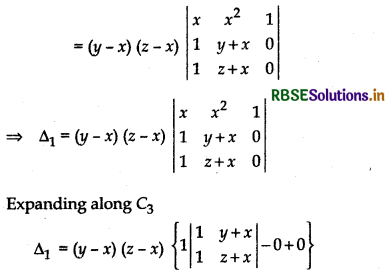
⇒ ∆1 = (y - x) (z - x) {1(z + x) - 1 × (y + x)}
⇒ ∆1 = (y - x) (z - x) {z + x - y - x}
⇒ ∆1 = (y - x) (z - x) (z - y)
⇒ ∆1 = (x - y) (y - z) (z - x)
[∵ (y - x) = - (x - y) and (z - y) = - (y - z)]
∴ ∆1 = (x - y) (y - z) (z - x) ...... (2)
Now ∆2 = \(\left|\begin{array}{ccc} x & x^{2} & p x^{3} \\ y & y^{2} & p y^{3} \\ z & z^{2} & p z^{3} \end{array}\right|\)
Taking x, y, z common from R1, R2 and R3 respectively and p from C3
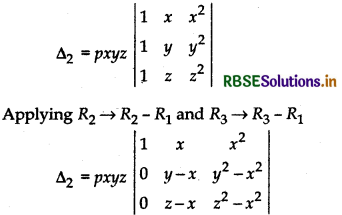
Again, taking common (y - x) and (z - x) from R2 and R3 respectively,
∆2 = pxyz(y - x) (z - x) \(\left|\begin{array}{ccc} 1 & x & x^{2} \\ 0 & 1 & y+x \\ 0 & 1 & z+x \end{array}\right|\)
Now, expanding ∆2 along C1
⇒ ∆2 = pxyz(y - x) (z - x) × \(\left\{1\left|\begin{array}{ll} 1 & y+x \\ 1 & z+x \end{array}\right|-0+0\right\}\)
⇒ ∆2 = pxyz(y - x) (z - x) × {1 × (z + x) - 1 × (y + x)}
⇒ ∆2 = pxyz{y - x) (z - x) (z + x - y - x)
⇒ ∆2 = pxyz(y - x) (z - x) (z - y)
⇒ ∆2 = pxyz(x - y) (y - z) (z - x)
[∵ (y - x) = -(x - y) and (z - y) = - (y - z)]
∴ ∆2 = pxyz(x - y) (y - z) (z - x) ....... (3)
Now, substituting the values of ∆1 and ∆2 in equation (1), we get
∆ = (x - y) (y - z) (z - x) + pxyz(x - y) (y - z) (z - x)
⇒ ∆ = (x - y) (y - z) (z - x) (1 + pxyz)
∴ ∆ = (1 + pxyz) (x - y) (y - z) (z - x)
= R.H.S.
Hence Proved.

Question 13.
\(\left|\begin{array}{ccc} 3 a & -a+b & -a+c \\ -b+a & 3 b & -b+c \\ -c+a & -c+b & 3 c \end{array}\right|\) = 3(a + b + c) (ab + bc + ca)
Answer:

⇒ ∆ = (a + b + c) {(a + 2b) (2c + a) - (- c + a) (- b + a)}
⇒ ∆ = (a + b + c) {2ca + a2 + 4bc + 2ba - (bc - ac- ab + a2)}
⇒ ∆ = (a + b + c) {(2ca + a2 + 4bc - bc + ac + ab - a2 + 2ab}
⇒ ∆ = (a + b + c) {3ab + 3bc + 3ca}
⇒ ∆ = (a + b + c) × 3 (ab + bc + ca)
⇒ ∆ = 3 (a + b + c) (ab + bc + ca)
∴ ∆ = 3 (a + b + c) (ab + bc + a)
Question 14.
\(\left|\begin{array}{ccc} 1 & 1+p & 1+p+q \\ 2 & 3+2 p & 4+3 p+2 q \\ 3 & 6+3 p & 10+6 p+3 q \end{array}\right|\) = 1
Answer:
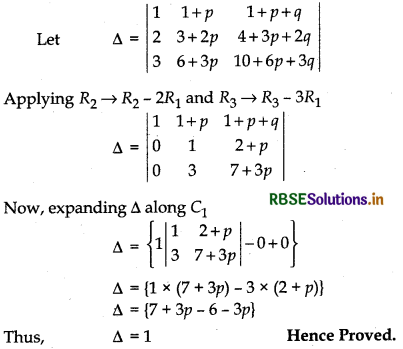

Question 15.
\(\left|\begin{array}{ccc} \sin \alpha & \cos \alpha & \cos (\alpha+\delta) \\ \sin \beta & \cos \beta & \cos (\beta+\delta) \\ \sin \gamma & \cos \gamma & \cos (\gamma+\delta) \end{array}\right|\) = 0
Answer:
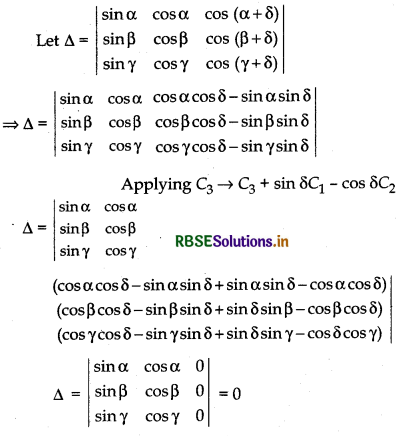
Thus, ∆ = 0 (all elements of C3 are zero)
Hence Proved.
Question 16.
Solve the following equations :
\(\frac{2}{x}+\frac{3}{y}+\frac{10}{z}\) = 4
\(\frac{4}{x}-\frac{6}{y}+\frac{5}{z}\) = 1
\(\frac{6}{x}+\frac{9}{y}-\frac{20}{z}\) = 2
Answer:
Given system of equation is
\(\frac{2}{x}+\frac{3}{y}+\frac{10}{z}\) = 4
\(\frac{4}{x}-\frac{6}{y}+\frac{5}{z}\) = 1
\(\frac{6}{x}+\frac{9}{y}-\frac{20}{z}\) = 2
Let u = \(\frac{1}{x}\), v = \(\frac{1}{y}\) and w = \(\frac{1}{z}\) then
2u + 3v + 10 w = 4
4u - 6v + 5w = 1
6u + 9v - 20w = 2
Writing in matrix form
AX = B ....... (1)
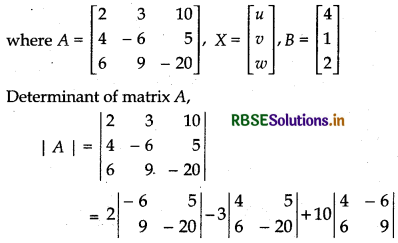
⇒ |A| = 2 × 75 - 3 × (- 110) + 10 x× 72
⇒ |A| = 150 + 330 + 720 = 1200
∴ |A| = 1200 ≠ 0
Since, matrix A is non-singular so A-1 exists.
If Aij is cofactor of aij in A, then
A11 = + [- 6 × (- 20) - 9 × 5] = 120 - 45 = 75
A12 = (- 1) [- 80 - 30] = (- 1) (- 110) = 110
A13 = + [4 × 9 - 6 × (- 6)] = 36 + 36 = 72
A21 = (- 1) (- 60 - 90) = (- 1) (- 150) = 150
A22 = + [- 40 - 60] = - 100
A23 = (- 1) [18 - 18] = 0
A31 = + [3 × 5 - (- 6) × 10] = 15 + 60 = 75
A32 = (- 1) (10 - 40) = (-1) (- 30) = 30
A33 = + [2 × (- 6) - 4 × 3] = - 12 - 12 = - 24
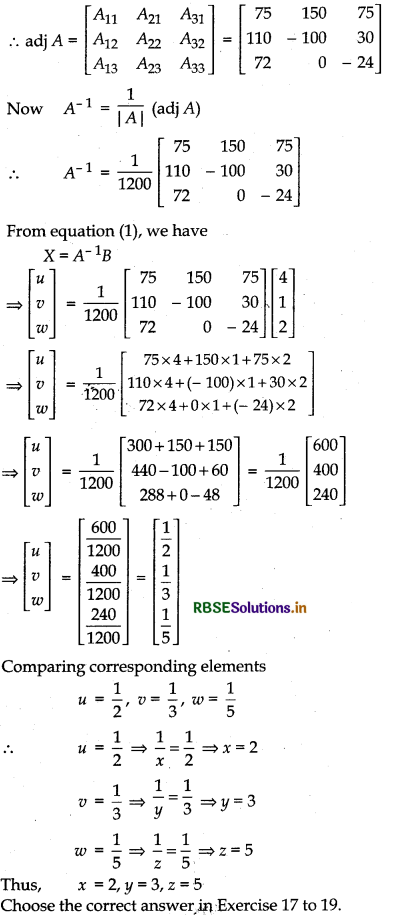

Question 17.
If a,b,c are in A.P., then the determinant \(\left|\begin{array}{lll} x+2 & x+3 & x+2 a \\ x+3 & x+4 & x+2 b \\ x+4 & x+5 & x+2 c \end{array}\right|\) is:
(A) 0
(B) 1
(C) x
(D) 2x
Answer:
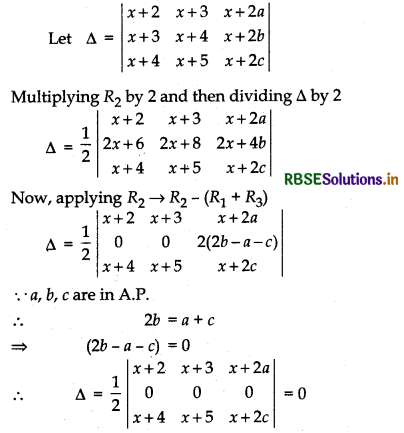
All element of R2 are zero.
Thus, option (A) is correct.
Question 18.
If x, y, z are non-zero real numbers, then the inverse of matrix A = \(\left[\begin{array}{lll} x & 0 & 0 \\ 0 & y & 0 \\ 0 & 0 & z \end{array}\right]\) is:
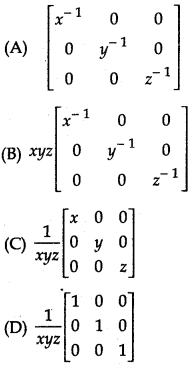
Answer:
Let A = \(\left[\begin{array}{ccc} x & 0 & 0 \\ 0 & y & 0 \\ 0 & 0 & z \end{array}\right]\)
∴ Determinant of matrix A is
|A| = x\(\left|\begin{array}{ll} y & 0 \\ 0 & z \end{array}\right|\) - 0 + 0
= x(yz - 0) = xyz
∴ |A| = xyz ≠ 0
If Aij is cofactor of aij in A, then
A11 = + [yz - 0] = yz
A12 = (- 1) (0 × z - 0 × 0) = 0
A13 = + [0 × 0 - 0 × y = 0]
A21 = (- 1) (0 × z - 0 × 0) = 0
A22 = + [xz - 0 × 0] = xz
A23 = (- 1) (x × 0 - 0 × 0) = 0
A31 = + [0 × 0 - 0 × y] = 0
A32 = (- 1) [x × 0 - 0 × 0] = 0
A33 = + [x × y - 0 × 0] = xy
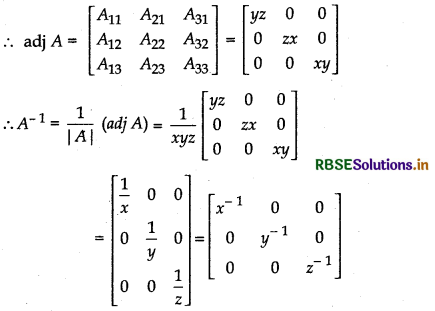
Thus, option (A) is correct.

Question 19.
If A = \(\left[\begin{array}{ccc} 1 & \sin \theta & 1 \\ -\sin \theta & 1 & \sin \theta \\ -1 & -\sin \theta & 1 \end{array}\right]\), where 0 ≤ θ ≤ 2π, then
(A) Det (A) = 0
(B) Det (A) ∈ (2, ∞)
(C) Det (A) ∈ (2, 4)
(D) Det (A) ∈ [2, 4]
Answer:
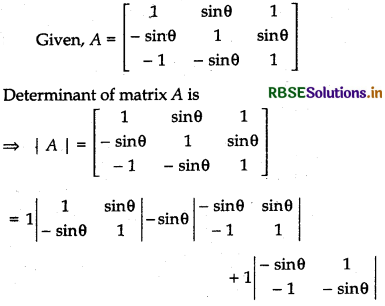
⇒ (1 + sin2θ) + (sin2θ - sin2θ) + (sin2θ + 1)
⇒ |A| = 1 + sin2θ + sin2θ + 1
⇒ |A| = 2(1 + sin2θ)
Now θ = 0, |A| = 2
θ = \(\frac{\pi}{2}\),
|A| = 2(1 + 1) = 4
∴ det (A) ∈ [2, 4]
Thus, option (D) is correct.

- RBSE Class 12 Maths Notes Chapter 13 Probability
- RBSE Class 12 Maths Notes Chapter 12 Linear Programming
- RBSE Class 12 Maths Notes Chapter 11 Three Dimensional Geometry
- RBSE Class 12 Maths Notes Chapter 10 Vector Algebra
- RBSE Class 12 Maths Notes Chapter 9 Differential Equations
- RBSE Class 12 Maths Notes Chapter 8 Application of Integrals
- RBSE Class 12 Maths Notes Chapter 7 Integrals
- RBSE Class 12 Maths Notes Chapter 6 Application of Derivatives
- RBSE Class 12 Maths Notes Chapter 5 Continuity and Differentiability
- RBSE Class 12 Maths Notes Chapter 4 Determinants
- RBSE Class 12 Maths Notes Chapter 3 Matrices